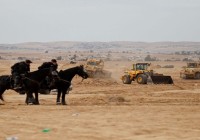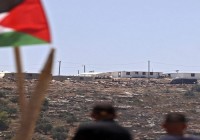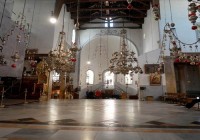Cement Black Market… Destroying Gaza’s Reconstruction Opportunities
Despite the presence of an International mechanism for monitoring cement sales for reconstruction, these snapshots of some the posts across the social networking site “Facebook” reveal a large defect in the monitoring system. Some merchants believe the government to be responsible for these defects.
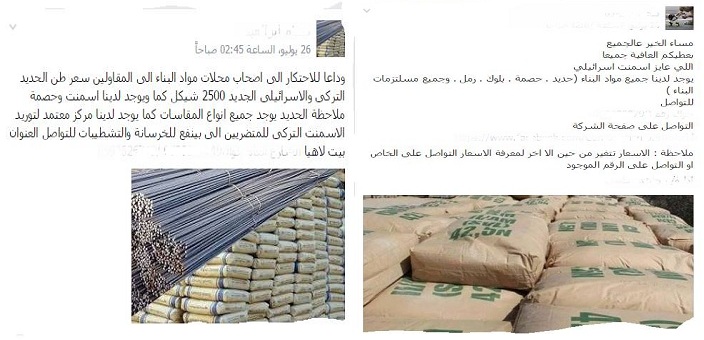
Merchants Using Social Networking Sites to Promote Cement at Prices that Outweigh the Real Price
Palestine Economy Portal- Islam Radi | “The Black Market” for cement trading, a state that observers have warned it would appear as a result of the United Nations mechanism for the reconstruction of Gaza. But day after day, and despite these warnings, Gazans are witnessing this black market widening and becoming a phenomenon that generates a lot of money for some merchants, taking advantage of the citizens’ needs, and forming a real threat to the reconstruction of Gaza.
According to both merchants and officials, the affected people are forced to sell their cement allocations because of the bad economic conditions they are going through, and also because the cement allocated to them is not enough for rebuilding their homes. Many of these people sell cement on the hope that they will be allocated other amounts in the future.
In accordance with the International mechanism for reconstruction, cement is sold for people with damaged homes at 540 NIS. Then, they resell it in the black market for prices that exceed 1400 NIS. Estimations show that about 70% of the cement for reconstruction has been sold in the black market.
Merchants: Weak Governmental Monitoring
Awad Jaa’rour, a construction materials merchant in Gaza, sees that people with damaged homes who receive construction materials are the main reason for the presence of the “black market”, as they sell these materials under the inexistence of governmental monitoring.
Jaa’rour is one of a hundred construction materials importers under the international mechanism. He refuses the charges that accuse importers of the revitalization of the black market, saying: “Our role is limited to receiving amounts of construction materials at Kerem Shalom crossing, and then delivering them to the recipients under the announced “coupon” mechanism.”
Jaa’rour says that surveillance cameras are the best evidence to deny the accusations. These surveillance cameras were imposed on construction materials importers as a condition to allow entry of cement, and they are periodically monitored by specialists from the International mechanism for reconstruction. There are eight surveillance cameras in Jaa’rour’s storehouse; three of them are in the block factory.
Based on his observations, he assures that a big number of people with damaged houses resorted to selling the quantities of construction materials they received, especially cement, to local traders at doubled costs, hoping to earn the difference between the two prices.
Cement at some of the importers’ storehouses in Gaza until it is delivered to the affected from the Israeli war
A big construction materials merchant in Gaza, who wished to stay anonymous, said that the poor evaluation of the conditions of the partially affected houses in many cases led to the growth of the black market, especially after the owners of these houses received quantities of construction materials double that they need.
He explained, “In reality, some of these people would deserve only 100 tons to complete restoration and rehabilitation of their homes, but they are given 150 tons. They sell the additional 50 tons at doubled prices, which increase the pace of demand on this kind of trading.”
The merchant blames the Ministry of Economy “For its staff do not monitor the buying and selling processes enough, they sometimes even get involved in turning a blind eye to a number of cases proven to be involved in black market activities.”
According to the merchants, the growth of the black market, and the lack of sufficient funds for the reconstruction of Gaza both led to the accumulation of over eight thousand tons of cement in some of the importers’ storehouses, threatened by loss of validity without being utilized.
The Government: We Monitor Strongly
On the other hand, Undersecretary of the Ministry of Public Works and Housing in Gaza Naji Serhan asserts that the ministry, in coordination with the Ministry of Economy, has taken strict and formal procedures, to reduce the black market phenomenon concerning the materials for the reconstruction of Gaza.
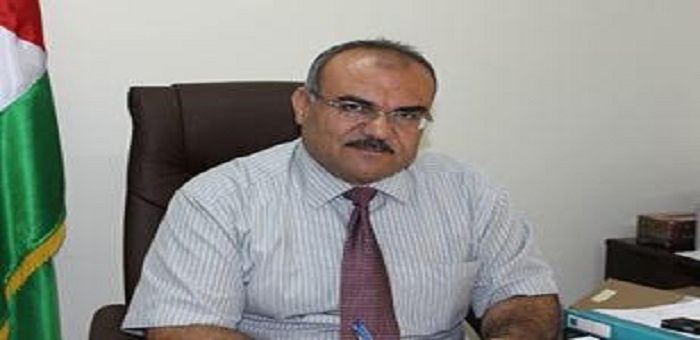
Undersecretary of the Ministry of Public Works and Housing, Naji Serhan.
Serhan told Palestine Economy Portal that they have confiscated large amounts of what has been sold in the black market, in order to return them to the beneficiaries in cooperation with the international organizations; stressing on the concerted efforts to fight this phenomenon, which is “an unacceptable exploitation.”
Serhan considers the Israeli occupation as the one responsible for the growth of the black market phenomenon in Gaza, as it reduces the amounts of construction materials that enter Gaza through the siege.
The Black Market… A Threat to Reconstruction
Regarding the effect of the black market phenomenon on the reconstruction of Gaza, Serhan says, “This phenomenon certainly affects reconstruction negatively. There is an agreement between the government and the International bodies to use the materials solely in reconstruction, but the presence of the black market gives the occupation an excuse to refuse the entry of these materials.”
Lately, reconstruction of the first batch of the totally destroyed houses as a result of the last Israeli aggression on Gaza was announced. However, it is believed that the construction works currently do not exceed 10 houses, though a whole year has passed since the war.
Serhan expects the reconstruction of Gaza to witness more improvement during the next phase, especially the part concerning the implementation of the Qatari grant to build 1000 housing units, and the Kuwaiti grant to build 1500 housing units, as they are working on completing these grants soon.
Nonetheless, what Khalil Ashour (citizen) says asserts that no one is innocent from the charge of illegal trading, as he was able to start reconstructing his home though his name was not included on the reconstruction list.
No One is Innocent
Khalil Ashour’s speech reveals that no one is innocent, as he was able to buy amounts of cement in non-official ways.
Ashour, a trader, said he had to buy small amounts of cement from a local trader at a doubled cost so that he could rebuild a part of his destroyed house in Juhr AdDik, to the south of Gaza City.
Ashour explained that he resorted to buying construction materials in an unofficial way after his many disappointments of being promised to receive some of the cement allocated for reconstruction, but never actually received any.
The Israeli Occupation is the One Responsible
Nabil Abu M’eileq, president of Contractors Union in Gaza, says the Israeli Occupation is the one responsible for stumbling the reconstruction of Gaza, as well as the growth of the black market phenomenon, because of the constraints it imposes on the entry of construction materials amounts, which leads to reducing them.
Nabil Abu M’eileq, President of Contractors Union in Gaza
Abu M’eileq told Palestine Economy Portal that Gaza Strip needs 6 thousand tons of cement on a daily basis because of natural growth, developmental projects, and the excess need for reconstruction. Therefore, the entry of small amounts of cement forces the affected population to sell what they receive in the black market, especially that they are not properly compensated.
He added, the presence of the black market phenomenon is very natural, as the market demand of cement and construction materials is very high, and the amounts allowed entry do not exceed 7% of this demand; therefore, this is considered a logical outcome compared to the big difference between supply and demand.
Abu M’eileq puts the blame on the International Mechanism for the reconstruction of Gaza, “as it is very shameful for the United Nations to work on managing the siege through imposing constraints on reconstruction rather than on ending it entirely, and ensuring the entry of all that Gaza needs from construction materials.”
He continued: “All materials should be allowed entry unconditionally for the construction and economic process to work smoothly, and to provide employment opportunities to reduce unemployment and poverty, which would result in stability in all aspects of life, especially economic one, and eliminate the black market phenomenon.
Reconstruction Data
In the context of the Gaza Reconstruction Mechanism (GRM) for the reconstruction of Gaza, the number of registered applications in the system for the owners of destroyed houses to purchase building materials under the interim mechanism reached 95,143 applications.
According to “The National Office for Gaza Reconstruction”, the amount of cement the Israeli Authorities allowed entry for to the Gaza Strip since the end of the last war on Gaza and until July 23 reached 102,478 tons (100,653 tons of them have been sold)
The National Office for Gaza Reconstruction observed the damage of 169,776 houses in Gaza as a result of the Israeli War: 12,558 were completely destroyed; 6,445 not fit for habitation; 6,150 slightly damaged; 144,223 partially damaged.
